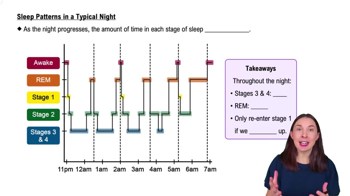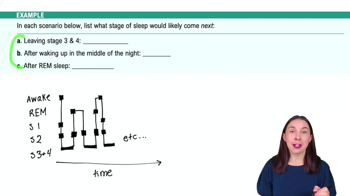Table of contents
- 1. Introduction to Psychology1h 43m
- 2. Psychology Research2h 20m
- 3. Biological Psychology2h 41m
- 4. Sensation and Perception28m
- 5. Consciousness and Sleep32m
- 6. Learning41m
- 7. Memory34m
- 8. Cognition37m
- 9. Emotion and Motivation35m
- 10. Developmental Psychology33m
- 11. Personality48m
- 12. Social Psychology41m
- 13. Stress and Health41m
- 14. Psychological Disorders44m
- 15. Treatment47m
5. Consciousness and Sleep
Sleep
Struggling with Psychology?
Join thousands of students who trust us to help them ace their exams!Watch the first videoMultiple Choice
_____ is characterized by delusions and paranoia.
A
Amphetamine psychosis
B
Tolerance
C
Withdrawal
D
Drug interaction
 Verified step by step guidance
Verified step by step guidance1
Begin by understanding the key terms in the problem: 'delusions' and 'paranoia'. These are symptoms often associated with certain psychological conditions or drug effects.
Consider the context of the problem, which involves drug-related terms. This suggests that the symptoms might be linked to the effects of a specific substance.
Review the options provided: 'Amphetamine psychosis', 'Tolerance', 'Withdrawal', and 'Drug interaction'. Each term has a specific meaning in psychology and pharmacology.
Analyze 'Amphetamine psychosis': This condition is known to cause symptoms such as delusions and paranoia, often as a result of high doses or prolonged use of amphetamines.
Compare the symptoms of 'Amphetamine psychosis' with the other options. 'Tolerance' refers to needing more of a drug to achieve the same effect, 'Withdrawal' involves symptoms when stopping a drug, and 'Drug interaction' refers to effects when drugs are combined. None of these directly describe delusions and paranoia.

 3:25m
3:25mWatch next
Master Circadian Rhythms with a bite sized video explanation from Hannah Gordils
Start learningRelated Videos
Related Practice


































































































![Race, Genes and IQ Differences | Bret Weinstein [Mini Clip]](https://img.youtube.com/vi/IztL_m3pd70/mqdefault.jpg)



































































































